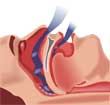Acupuncture Improves Sleep
A recent study shows that acupuncture as a treatment for obstructive sleep apnea (OSA) has immediate effects in reducing nocturnal respiratory events, sleep disruptions, and desaturations (low oxygen levels in the blood). The researchers hypothesize that this improvement is due to acupuncture’s effects on serotonergic pathways and also acupuncture’s anti-inflammatory effects. Both manual acupuncture and 10Hz electro-acupuncture techniques were found effective. Both techniques produced superior clinical outcomes compared with 2Hz electro-acupuncture.
Acupuncture Technique used by Acupuncturists
The researchers used classical acupuncture techniques and acupuncture points in their study. The acupuncture points chosen for the study were: Lu6, Lu7, LI4, LI20, GV20, CV23, St36, St40, Sp6, K6, and extra point Shanglianquan (located near the hyoid bone). Copper-handle 40 X 0.25mm needles were used and inserted to traditional depths. Electro-acupuncture was applied to the neck points CV23 and Shanglianquan and a separate pair were connected to LI4 and St36. Electro-acupuncture stimulation had wave pulses of 0.45 ms2 at 10Hz and increased to an intensity of between 0.6 - 0.8 mA which produced a mild twitch. The manual acupuncture group receive manual stimulation to the needle until deqi (sensation of heaviness or numbness) was achieved at each acupuncture point. The needles were retained for 30 minutes.
Acupuncture Testing Procedures
Laboratory findings used electroencephalography, electromyography, and electrocardiography. This tested respiration, mouth flow, and pulse oximetry with the use of an oximeter. Subjects were chosen for the study from a randomized process. Blinded independent researchers followed four groups: manual acupuncture, electro-acupuncture at 10Hz, electro-acupuncture at 2Hz, control group. The researchers note that the electro-acupuncture was not tested for analgesia but rather for its effects on the lack of motor competence as a result of inflammation and other mechanisms responsible for reducing the activity of airway muscles.
Discussion of Acupuncture and Airflow
The researchers note that the acupuncture points of the neck are of specific interest because they stimulate the genioglossus muscle (secondarily, the mylohyoid muscle) on deep insertion. They note that stimulation of this lingual muscle affects airflow dynamics and may be a key reason as to why acupuncture is effective for improving the symptoms of patients with sleep apnea.
Reference:
Immediate effect of acupuncture on the sleep pattern of patients with obstructive sleep apnoea, Anaflávia O Freire, Gisele C M Sugai, Sônia Maria Togeiro, Luiz Eugênio Mello, Sérgio Tufik; Acupunct Med 2010;28:115-119.


